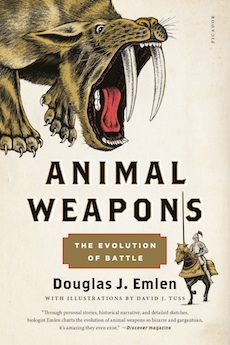Winner of the 2015 Phi Beta Kappa Award in Science
By Lewis Fried
Do creatures exist having neither weapons nor protective behavior? A good starting point lies in a somewhat different investigation: how do “extreme” animal weapons develop and what circumstances drive this growth? Is there a continuum in which humans and “animals” stand analogously or evolutionarily as makers and/or bearers of extreme weapons? More to the point, what can dung beetles in specific and animals in general reveal about human behavior and possibilities. Douglas J. Emlen’s Animal Weapons, a fascinating and compelling book, raises these and other questions.
Fascinated with extreme weapons, Emlen advanced his studies with dung beetles. They were opportune: they were abundant in nature, observable, and could live in a laboratory. And many of them sported extreme weapons. These last, Emlen writes, are “structures so gargantuan and bizarre [that] they look like they shouldn’t be possible.” Moreover, these “arms” are ubiquitous. Ironically, they may be awkward; they may lead to their bearer’s death; they may impede an animal’s movement. And, they are often heavy consumers of energy and nutrients that weaken the animal itself. Think of deer whose antlers lock during battle; and, of a medieval knight whose armor was so heavy that once unhorsed, the protective helmet, chain mail and metallic plates made him slow, if not useless, for quick, close combat. He became something of a standing target. Speed is traded for protection, yet protection is vulnerable to an agile, quick opponent.
Enormous size can also function as a deterrent to battle, frightening opponents. Examples are plentiful: a salient one is the male fiddler crab with an outsize claw that signals danger to other males. However, there are trade-offs: the male dung beetle with large horns has “proportionally smaller eyes.” Or, for that matter, look at powerful weapons deployed by the military: machines and armaments are so heavy and difficult to maneuver that they bog down soldiers moving them.
These brief descriptions lead us to conclude that in many ways we are linked to other species by our behaviors and creativity. How did the momentum, then, for extreme weapons come about? And how might it be stalled? Is this an evolutionary phenomenon developing in predictable patterns and ways? Or does it mark the possessor as a “sport,” to use Darwin’s term. In a sentence that can be read either as an enormous leap or as a strong declaration, Emlen points out: “Humans evolve and our weapons evolve, but these events unfold independently. As long as this distinction is clear, there’s no reason why we can’t compare the evolution of animal weapons to the evolution of weapons we build.”
The search for chance and causality runs across species. Here, Emlen paints on a large canvas with a fine brush. His examples range from small insects to sizable animals, and from early weapons to those of mass destruction. Three “factors” make possible an “arms race”: strong competition by males for females; available, and hence local, resources that are defensible; and duels. In his words: “For bigger weapons to perform better than smaller ones, the battles must be matched and symmetrical.” Yet once extreme animal weapons prove too economically or physiologically expensive, smaller weapons now come into their own. The costs are matters of life or death: “In theory,” Emlen argues, “if populations with costly weapons fail to lose them fast enough, they may even suffer extinction.”
How then, have we and other species survived? Will there be a mischance that is death for us? One answer is found in reading signals an opponent sends out, gestures that are unambiguous but can be challenged if one is overly brave or foolhardy. Prudence comes down to recognizing “deterrence.” We are brought back to the fiddler crab with its enormous, menacing claw. The crab has many challengers, but given its oversized weapon, they back away. In other words, when choosing a battle, act wisely. However, deterrence is not an insuperable barrier to destruction. It simply means that weapons of mass destruction may be less likely to be used—if decisions are judiciously made.
In a world in which power and intention are often asymmetrical, in which there are state as well as non-state agents, in which groups hope and have the means to trigger an apocalypse, how long will we survive? The last sentence of this book plucks the bass string: “Weapons of mass destruction change the stakes, and the logic of battle. We’re not likely to survive another arms race.”
Lewis Fried (ΦBK, Queen’s College, CUNY, 1964) is Professor of English Emeritus at Kent State University and a resident member of the Nu of Ohio chapter of Phi Beta Kappa.




